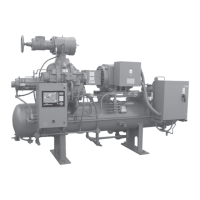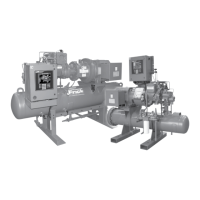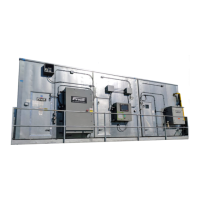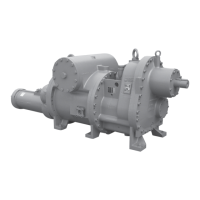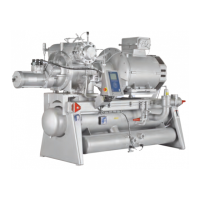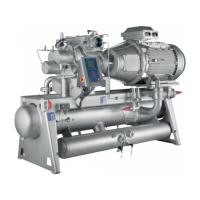RWF II ROTARY SCREW COMPRESSOR UNITS
INSTALLATION
070.610-IOM (JUN 11)
Page 11
If the backpressure regulator valve is not used on a ash
economizer, it is possible that no pressure difference will exist
to drive liquid from the ash vessel to the evaporators, since
the ash vessel pressure will approach suction pressure at a
decreased slide valve position. In cases where wide swings
in pressure are anticipated in the ash econo mizer vessel, it
may be necessary to add an outlet pressure regulator to the
ash vessel outlet to avoid overpressurizing the economizer
port, which could result in motor overload. Example: A sys
tem feeding liquid to the ash vessel in batches.
The recommended economizer systems are shown in Figures
811. Notice that in all systems there should be a strainer
(STR) and a check valve (VCK) between the economizer ves
sel and the economizer port on the compressor. The strainer
prevents dirt from passing into the compressor and the check
valve prevents oil from owing from the compressor unit to
the econo mizer vessel during shutdown.
Other than the isolation valve
needed for strainer cleaning, it is
essential that the strainer be the last
device in the economizer line before the compres sor. Also,
piston-type check valves are required for installation in
the economizer line, as opposed to disc-type check valves.
The latter are more prone to gas-pulsation-induced fail-
ure. The isolation and check val ves and strainer should
be located as closely as possible to the compressor, pref-
erably within a few feet.
For refrigeration plants employing multiple compressors on
a common economizing vessel, regardless of economizer
type, each compressor must have a backpressure regulat
ing valve in order to balance the economizer load, or gas
ow, between compressors. The problem of balancing load
becomes most important when one or more compressors
run at partial load, exposing the economizer port to suction
pressure. In the case of a ash vessel, there is no need for
the redundancy of a backpressure regulating valve on the
vessel and each of the multiple compressors. Omit the BPR
valve on the ash economizer vessel and use one on each
compressor, as shown in Figure 11. It is also recommended
that the backpressure regulating valves, used on economizer
lines, should be specied with electric shutoff option. The
electric shutoff feature is necessary to prevent ow from the
common economizer vessel to the suction side of a stopped
compressor, through the suction check valve bypass line, if
the other compressors and the common economizer vessel
are still operating and the HV2 valve on the suction bypass
is open.
For refrigeration plants using a Packaged Refrigerant Recir
culation Unit and a direct expansion (DX) economizer system
it is necessary to operate the liquid feed solenoid on the unit
and the liquid feed solenoid on the DX vessel off of a common
signal to avoid liquid overfeed on the DX economizer system.
If multiple compressors are operated with a common
economizer vessel, it is necessary to install a backpressure
regulator valve with an electric shutoff option in the vapor
line piped to the compressor's economizer port.
ECONOMIZER LOAD BALANCING
The most energy efcient manner to operate an economizer
system, when using multiple compressors on a common
economizer vessel, is to take as much of the ash gas as
possible to the compressors that are fully loaded. This can
be done in at least two ways.
1. Use the economizer output from the microprocessor to
turn off a solenoid, or to actuate the electric shutoff option
on a backpressure regulator, based on percent of slide valve
travel. This will direct all the ash vapor to the other loaded
compressors.
2. A dualsetpoint, backpressure regulator valve can be
used in each of the individual economizer vapor lines. When
a compressor is running near full load, the BPR valve will
operate on the desired setpoint, or basically wide open, to
minimize pressure drop in the line. When one compressor
unloads below the slide valve position where the economizer
output on the microprocessor turns on, the dualsetpoint
feature of the regulator can be actuated by this output to
control the pressure, on the vessel side of the regulator, to
be a few psi higher. Consequently, the ash gas will be sent
to the loaded compressors rst, until they can’t handle all
the vapor and the pressure in the vessel starts to rise. Then,
some of the vapor will go to the unloaded compressor to
help maintain the vessel at the desired pressure. An example
of a backpressure regulator with electric shutoff and the
dualsetpoint feature is an R/S A4ADS.
ELECTRICAL
NOTE: Before proceeding with electrical installation, read
the instructions in the section “Proper Installation of Elec-
tronic Equip ment in an Industrial Environment”.
RWF II units are supplied with a Quantum™LX control sys
tem. Care must be taken that the controls are not exposed
to physical damage during handling, storage, and installa tion.
The singlebox control door must be kept tightly closed to
prevent moisture and foreign mat ter from entry.
NOTE: All customer connections are made in the single-
box control mounted on the oil separator. This is the ONLY
electrical enclosure and it should be kept tightly closed
whenever work is not being done in it.
VOLTAGE PROTECTION
Frick
®
does not advise nor support the use of UPS power
systems in front of the Quantum
™
LX panel. With a UPS power
system providing shutdown protection for the Quantum
™
LX,
the panel may not see the loss of the 3phase voltage on
the motor because the UPS could prevent the motor starter
contactor from dropping out. With the starter contactor still
energized, the compressor auxiliary will continue to feed
an “Okay” signal to the panel. This will allow the motor to
be subjected to a fault condition on the 3phase bus. Some
fault scenarios are:
1. The 3phase bus has power “on” and “off” in a continu
ous cyclic manner which may cause the motor to overheat
due to repeated excessive inrush currents.
2. Motor cycling may damage the coupling or cause other
mechanical damage due to the repeated high torque motor
“bumps”.
3. Prolonged low voltage may cause the motor to stall and
overheat before the motor contactor is manually turned off.
Under normal conditions, the loss of 3phase power will shut
down the Quantum
™
LX panel and it will restart upon power
return. If the panel was in:
• Auto – Compressor motor will return to running as pro
grammed.
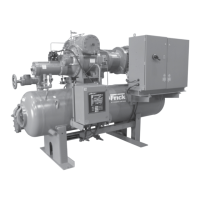
